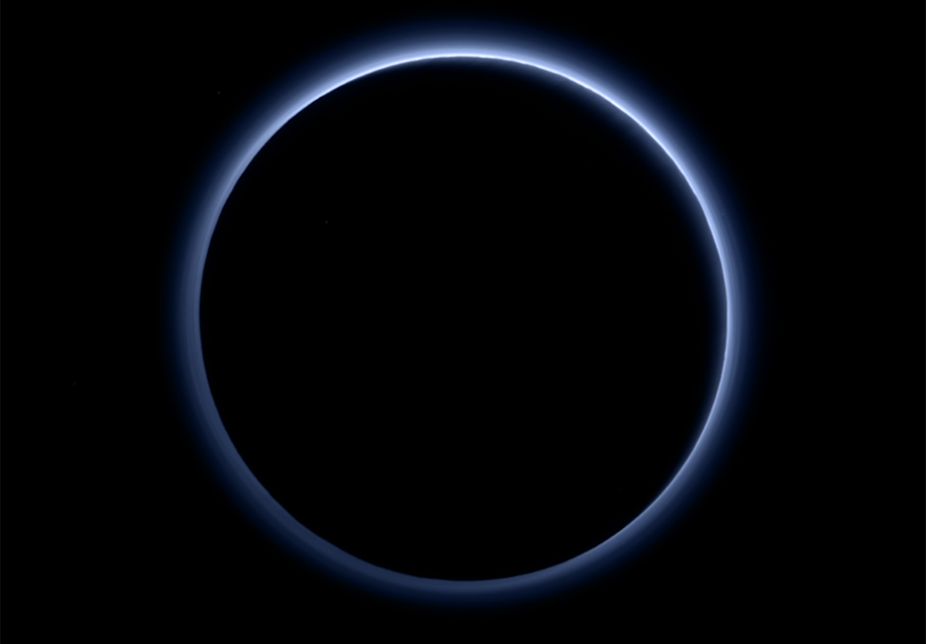The solar system beyond Earth is often depicted as a dark, hostile and barren place where you absolutely wouldn’t want to get stranded. But the latest results from a pair of intrepid explorers have once again confounded the expectations of planetary scientists. They reveal blue skies over Pluto and an ancient, tranquil lake on Mars that could have supported life.
This time last year, our best picture of Pluto was a grey, fuzzy undistinguished blob with no redeeming features. What a difference a 15 minute fly-by makes.
Since the New Horizons mission started returning data in July, we have seen amazing landscapes, including a vast and smooth icy plain bordered by jumbled blocks of ice and rock, as well as patterned ground that has been described as having a texture like a snakeskin.

We have seen ripples and ridges, things that look like mosaics of plates of ice and things that look like river valleys. And now we have learnt that these features all lie below a blue sky. Does this remind you of somewhere else? We too are enveloped in a thin blue coat. The colour of our sky, and Pluto’s, is caused by the same mechanism – the scattering of light by small particles in the atmosphere, with the main constituent being nitrogen.
But there the similarities end. For a start, Earth’s atmosphere is about 100,000 times as dense as Pluto’s, and its second highest component is oxygen. On Pluto, nitrogen is accompanied by methane, and it is probable that the particles which scatter light are a group of molecules called tholins. These are formed when ultraviolet radiation (from the sun) breaks up molecules (like nitrogen and methane), which then react together, producing more complex molecules.
What’s really interesting about tholins (which are also present in the atmosphere of Saturn’s giant planet Titan) is that they can keep reacting with newly broken-up molecules, growing larger and larger. They may become coated with ice, and then fall as snow or hail onto Pluto’s surface. Now Pluto is far too cold for much more to happen to these molecules – but in a warmer environment, say, to take a planet at random, the Earth about 4.5 billion years ago, maybe they could be the organic seed that eventually led to biology? Unfortunately Pluto is not the best candidate for extra terrestrial life. That spot belongs to Mars.
Life-friendly lakes on Mars
That brings me to the lakeside – or at least, the rocks and sediments left behind when a lake evaporated away. We heard only last week that observations of gullies on Mars implied that liquid water might still be present. This week, in a very detailed article in the journal Science, NASA scientists describe the geology of Gale crater, which is being explored by the Curiosity rover.

Here, water was present some 3 and a half billion years ago, forming a lake within an impact crater. The rims of the crater were eroded by a combination of wind and rivers, which carried the sediment into the crater, gradually building up to fill it completely. The sediments draped over the central part of the crater, to form the mountain called Mount Sharp.
The lake was probably episodic, growing and shrinking with changes in climate. Some of the sediments are more like those which would be characteristic of a delta, recording times when the lake was drying up, showing river deposits fanning out across an exposed surface, rather than settling out into deeper water. What is most interesting about the findings (as well as the amazing images of sedimentary rocks) is that there are no signs of a cold climate.
There is no evidence of glaciation. No frost wedges (deep cracks produced during freeze/thaw episodes) or glacial dropstones (rocks transported by a glacier, then dropped as the glacier – or iceberg – traverses the lake). All there is is 75 metres of rock that represent deposition of sediment into a substantial body of standing water – water that must have been present for hundreds of thousands, if not millions of years. So what was happening on Mars during this period?
The authors point out that, at the time, Mars’ axial tilt was higher than it is at present. Back then it was tilted more towards the Sun, resulting in greater swings in temperature between seasons. How thick was the atmosphere? Was there a greater volume of volatiles, produced by increased volcanic activity, contributing to a warmer climate?
The concluding sentence of the article summarises how these findings continue to keep Mars as the “hot” favourite for extraterrestrial life: “Our results show that water pooled there, in surface and subsurface reservoirs, for a geologically and perhaps biologically relevant period of time.”
If we link this sentence with the observation that water might still be present in sub-surface brines – then maybe Mars isn’t quite so dead after all – and the Martian might have had to battle potato blight as well as everything else.

